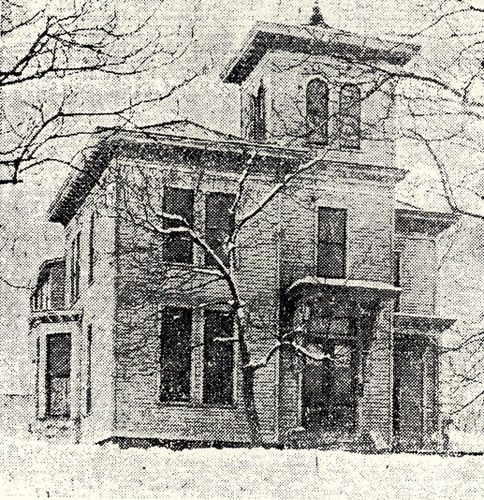
Photo from ARCH collection; courtesy of Kevin Mann, Fort Wayne, Indiana

Once home to wealth and fame, it had been marked for demolition.
To see it now, you’d never know it was once home to one of early Fort Wayne’s wealthiest and most prominent residents – and, later, two internationally known performing dwarfs: “Commodore Foote” and “The Fairy Queen.”
In fact, the building is in such disrepair that the city’s Neighborhood Code Enforcement office ordered it torn down a year ago – an execution stayed only because of what the house used to be.
Now, there is finally reason to believe the long-vacant Fairfield-Nestel house at 815 W. Creighton Ave. will have a future, not just a past.
Angie Quinn, executive director of the local historic-preservation group ARCH, said an Illinois investment group that bought the house at an Allen County-sponsored sale of tax-delinquent properties has agreed to donate the home to ARCH – which will in turn sell it to someone willing and able to restore its long-lost charm.
Chant Nelson, a 40-year-old San Francisco contractor with ties to Fort Wayne, insists he’s the man for the job. Nelson said he hopes to buy the house within weeks, then restore it as a single-family home he could use when visiting his parents and other relatives. “Mom might keep some of her antiques there,” said Nelson, who left Fort Wayne for the West Coast in 1991.
The antiques would feel right at home. According to Michael Galbraith, ARCH’s historic-preservation specialist, the house is one of Fort Wayne’s oldest and best examples of “Italianate villa” architecture – homes featuring relative flat roofs, tall, narrow windows, carved brackets under the eaves and, sometimes, a tower.
The house’s tower is long gone, but enough remains to evoke memories of the mid-1800s, when sea captain Asa Fairfield came to Fort Wayne from Kennebunkport, Maine, with $30,000 – an unprecedented fortune in Fort Wayne at that time, according to historian Charles Poinsatte.
Fairfield used part of the money to buy 240 acres on what was then the edge of town, and in 1858, at the highest spot on his property, he began work on the house that would bear his name – in between trips as the master of the first boat to operate on the Wabash and Erie Canal.
Broadway Nursery owner Daniel Nestel bought the home in 1880, but it was the presence of his children, Charles and Eliza, that really added to the house’s legend. Standing less than 4 feet tall but perfectly proportioned, both toured the world and were far better known by their stage names.
“Can you imagine those ‘little people’ walking out those (massive) doors?” Quinn asked?
Given the house’s poor condition, that requires a lot of imagination. Although the home is structurally sound, there are holes in the roof and windows, the paint is peeling, exterior woodwork is missing or rotted, and the grounds are littered with dead trees, weeds and poison ivy. Inside, some historic features remain but many more have been removed – the product of the home’s use as a hospital in the 1920s and, later, as apartments.
Terms of the sale, however, will require the new owner to restore much of what time and neglect have destroyed. The house was listed for sale at about $15,000 but could cost $80,000 just to “stabilize,” Galbraith said – although that figure could be lower if the new owner does some of the work himself.
Because the house has already been designated a local historic district, the exterior must be restored in a historically sensitive manner approved by the city’s Historic Preservation Review Board. All existing building code violations must be corrected, as well. And, under terms of the owners’ agreement with ARCH, the house must be occupied within three years.
That last stipulation is designed, in part, to prevent what happened when ARCH successfully saved other endangered historic homes in the early 1980s. Two homes were moved to the 330 block of East Berry Street, but remained unoccupied for years while renovation proceeded at a snail’s pace.
But moving a historic home is a last resort, Quinn said, because the location is part of its history. ARCH’s role as an intermediary in this case may serve as a model for future salvage efforts – at least Quinn and Galbraith hope so.
“ARCH’s mission is to preserve our heritage,” Galbraith said.
“It had been vacant for so long, we wanted to find someone who would show some love for the home.”
Given the amount of work and expense ahead of him, Nelson’s affection for the home is indisputable. So is the value of saving and restoring the grand old home of Fort Wayne’s first canal boat captain, Commodore Foote and the Fairy Queen.
Kevin Leininger’s column appears in The News-Sentinel every Tuesday, Thursday and Saturday. Leininger has been with The News-Sentinel for more than 27 years, 11 of which were as an editorial writer. The column reflects his opinion, not necessarily that of The News-Sentinel, and discusses issues affecting Fort Wayne. To pass along ideas or feedback, contact him at kleininger@news-sentinel.com, or call 461-8355.
© 2007 News-Sentinel and wire service sources. All Rights Reserved.
FortWayne.com




